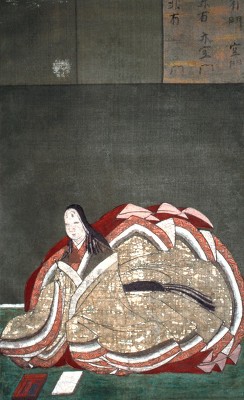Having studied theology and mediaeval history before, I come to today’s subject with a particular bias and worldview. Yet, having done so, I see many analogies between The Tale of Genji by Murasaki Shikibu and Dante’s The Divine Comedy through a Christian conception and frame [1]. The plot of The Tale of Genji instantiates the views held by the Buddhist religion, where we see no consolation for the sufferings of the world and which aligns closely with some aspects of mediaeval Christian thought.
Whereas Christianity did not have a wheel of rebirth, it did have the resurrection and recreation after death. In each case, the sufferings in this world remain in this world, and any consolation is to come in the next.
In the 11th century, when Murasaki Shikibu composed her work, the author was a female courtier or lady in the ruling feudal court. Around the end of the first millennium, the literary language deployed within the court by men was Chinese. Scholarly works written by women were not taken seriously, were often overlooked, and could get away with detailing personal accounts of the author’s life in the halls of power. The Tale of Genji was written as a novel, maybe one of the first novels ever. It is written in a prose form that was not considered worthy of the men in the court at the time. Male nobility writing at the time would write in poetry for the most part.
The author displays an impressive knowledge and comprehension of the forms of poetic art from both the Japanese and the Chinese courts of the time. The novel incorporates a little under a thousand waka or courtly poetic forms throughout its pages.
The novel encapsulates the changing nature of aristocracy in the early Heian period of Japanese life. As a woman, the writer can capture the manner of dress in daily life and reflect upon society's moral code throughout the era. In many ways, there is a Buddhist undercurrent to her work, capturing the transient nature of life. It captures the profound understanding of human emotion and the darkening of the soul as beauty fades and what an individual desires slips away. The Japanese world was changing as the old forms of aristocracy faded and new power structures evolved, causing upheaval and leading many to think the world was coming to an end or no longer worth living in.
The Hut…
Chōmei’s small hut reflects an image of a changing flowing river. Here, we see the change from the aristocratic period to a time of tumult and more change. As Japan transitioned from the patrician Heian era to the Shogunate rule, military rulers captured control of the state. Many former aristocrats rejected such changes, moving out of the central polity and into the life of a recluse who would see the changes that occurred as being reflected in the cyclic cosmology of Buddhist mythology.
As the river is never the same, all things change. To Chōmei, the continuous upending was seen as a reason not to engage in building and creation, but rather to reject society. He saw the building of a house in the capital as being “particularly vain”. In some ways, we see a philosophy analogous to that of Locke and Heraclitus. In both cases, it was a philosophy of acceptance, and believing that the transience and fragility of the world mean that we need to forgo seeking change because it would be beyond what the author saw as reasoned.
As with Heraclitus, Chōmei saw the flow of the universe as a river: “The current of a flowing river does not cease, and yet the water is not the same water as before. The foam floats on stagnant pools, now vanishing, now forming, never stays the same for long. So, too, it is with the people and dwellings of the world.” The Buddhist ideology of not being attached to the world can be seen in the same writing. We see a focus on suffering through life and in a 10 ft² hut, alongside an expression of aesthetic values.
Personally, the move towards occlusion and the rejection of life is something that I see as nihilistic. The author has rejected the world in what he sees as spiritually meaningful, but in reality, it is a rejection of that which matters most. In doing so, Chōmei says that the path is not on earth, but covers his own fear. If he is genuinely Buddhist and truly does not see value in the world, he should not be afraid. His reclusion takes him away from other people, and he becomes isolated and withdrawn. The argument is that it mirrors Amida Buddha, but I would argue that it is merely a cover for his fear.
The change that is occurring throughout Japanese society is something that he could help guide. Yet, he seeks to embrace the past and capture something that was, rather than look to the future. Chōmei is in a state of self-delusion where he seeks to make others believe that he is above the world, where, in reality, he is merely hiding from it.
Chōmei rejects the formal life that he had been a part of. He rejects the society that he was once proud to be a part of. As with Nietzsche, we see the concept of active nihilism where one seeks to destroy that which one no longer believes. It does not mean destroying it for everybody, but rather for oneself. And so, Chōmei turns away from his former life, and seeks to annihilate all that is outside of his own soul and to embrace a concept that the world is not real.
He says that he feels no fear, which does not mean that he does not feel fear.
References
[1] Dante, A. (2001). The Inferno (J. Ciardi, Trans.; A. T. MacAllister, Intr.). Duke University Press. (Original work published in the 14th century)
[Image: Kanō Takanobu, Public domain, Wikimedia Commons]

